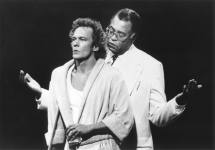Last Tuesday afternoon at the Japan America Theater, a lucky few witnessed an unforgettable demonstration of the acting art. It was just one scene from Tennessee Williams’ CAT ON A HOT TIN ROOF. It was just two actors with only a few props.
 But
it wasn’t just any actors. James Earl Jones and
James Morrison portrayed plantation owner Big Daddy and
his son Brick as if they were born to the roles. Each
brought Williams’ text vividly alive. Both were
utterly believable as they feuded in that Mississippi
Delta plantation home. Only one doubt shadowed their
superb work: Jones is a black man and Morrison is a white
man.
But
it wasn’t just any actors. James Earl Jones and
James Morrison portrayed plantation owner Big Daddy and
his son Brick as if they were born to the roles. Each
brought Williams’ text vividly alive. Both were
utterly believable as they feuded in that Mississippi
Delta plantation home. Only one doubt shadowed their
superb work: Jones is a black man and Morrison is a white
man.Despite their astonishing teamwork, such an obvious contrast triggered a multitude of questions about them as father and son. Would Big Mama be a mulatto? What about Maggie the Cat? Would she be Siamese?
Of course, such questions were not the point because these two Jameses came to us courtesy of the Non-Traditional Casting Symposium. The fifth in a national series designed to encourage the casting of ethnic, female and disabled actors in roles traditionally given to white males.
This symposium lasted from 10 in the morning to 10 at night. Scenes from plays as diverse as Moliere’s IMAGINARY INVALID (with Hispanic actors), Ibsen’s HEDDA GABLER (with a black Hedda) and John Patrick Shanley’s SAVAGE IN LIMBO (with a physically handicapped Savage) were aimed toward the breakdown of stereotypical casting. Panel discussions followed the performances.
But this critic wasn’t convinced. I was profoundly moved by Jones and Morrison, but I wondered how the text was meant to be interpreted.
CAT is set in the Deep South in 1955, before Martin Luther King Jr. led civil rights marches that cracked a few of the "separate-but-equal" Jim Crow laws. No matter how convincing an actor Jones can be, he can’t eliminate questions about his white son and ownership of "28,000 acres of the richest land this side of the valley Nile."
Here non-traditional casting fundamentally changes the subtext of Williams’ world. It gives his son, Brick, another set of motives for resisting his father’s power. In fact, it implies that the Jim Crow South was far more open, that the white majority racist society was a tolerant one. Williams’ Big Daddy, after all, is liberal with the epithet "coons," and he built his plantation on the backs of cheap black labor. In a full-length version, would Jones as Big Daddy imply that blacks are equal-opportunity exploiters?
It’s naive to assume that the horrendous racial conflicts permeating our society will vanish if in our theaters we simply pretend they don’t exist. Somewhere in our society there must be a sanctuary for the raw, unadorned truth, and our theaters are the last, great multiracial hope.
Playwright August Wilson is opposed to the idea that white and black actors can be transplanted without damaging text and context.
"It denies them their basic humanity, their right to stand on a stage as who they are: African-Americans... The important thing is that blacks would not act or talk like white characters in white plays."
Local Hispanic playwright Paul Hidalgo-Durand attended the entire symposium. By evening, he was furious.
"I wondered how important is it really that a Hispanic, black or Asian actor play a role in THE GLASS MENAGERIE? Plays are supposed to tell us about where we come from and what our life is like. Contradicting this, of course, is the statistic that 90 percent of all plays produced regionally are acted by white males. This does not represent the world in which we live. In order to change this figure, I don’t think the answer is non-traditional casting. The answer is in creating a library of new work by minority writers."
Still, so called "rainbow" casting worked well in Elizabeth Swados’ musical RUNAWAYS because the text was about multiracial youth. It worked in Peter Brooks’ staging of the Hindu epic MAHABHARATA because such a a visionary approach is crucial to Brooks’ internationalism. It works when Iranian- Italian Reza Abdoh truly employs "colorblind casting" in the process of creating new work.
It doesn’t work when you’re trying to bring truth to a classic like CAT ON A HOT TIN ROOF. Synopsized from a review by Richard Stayton, theatre critic for Herald Examiner

